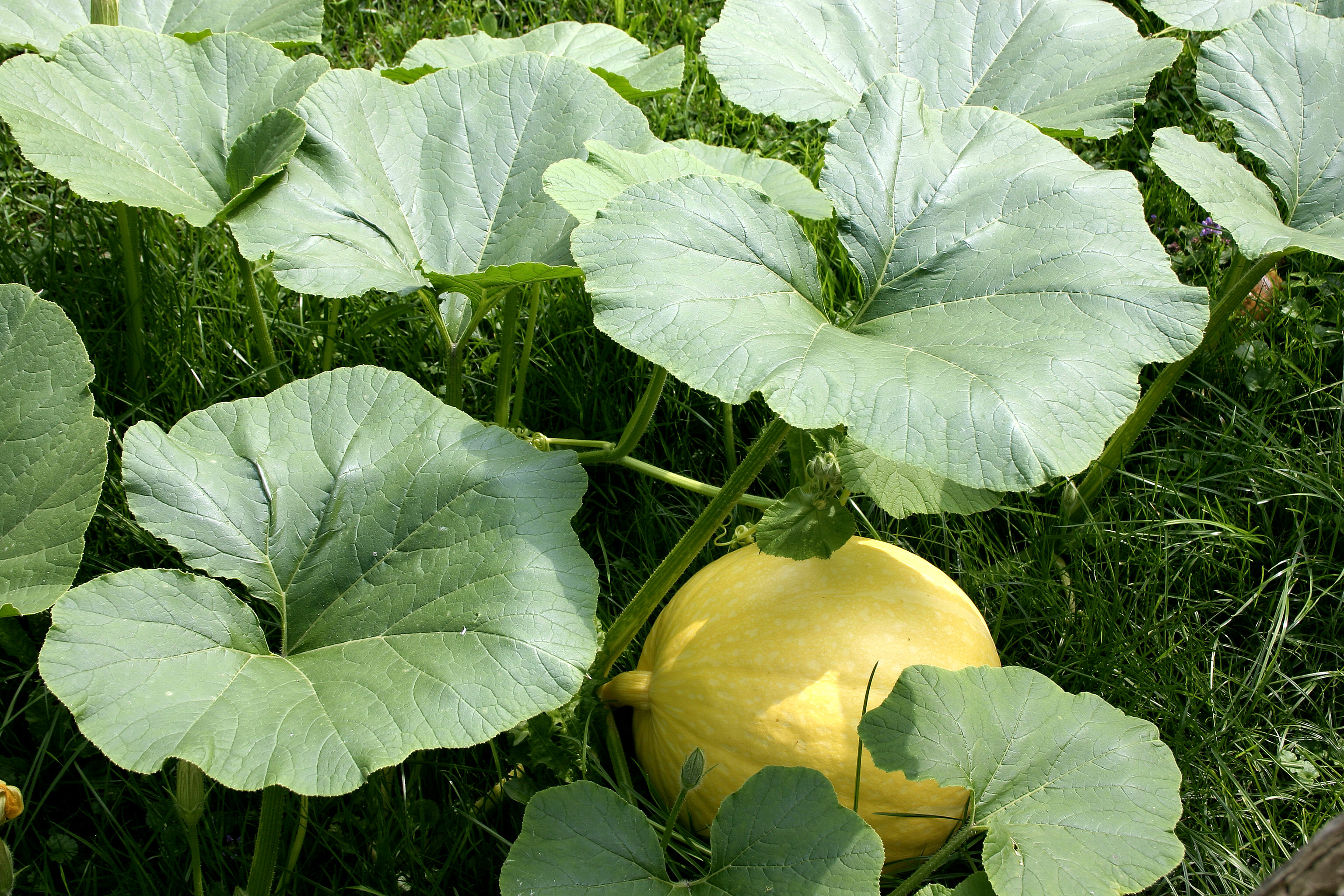Winter squash or pumpkin (Cucurbita spp.) is a gourd crop of food and fodder value.

Source: commons.wikimedia.org©Nino Barbieri (CC BY-SA 2.5)
Economic importance
Pumpkin with yellow flesh contains a lot of phosphorus, carotene, phytoncides. The fruits are used to make candied fruits and honey (from juice).
Forage varieties of pumpkin are used for livestock feed, they have a milk-producing property. 100 kg of fodder gourds correspond to 10 feed units and contain 70 g of digestible protein.
The average chemical composition of pumpkin fruits: dry matter – 8-12%; protein – 1.0%; carbohydrates – 6.5%; pectin substances – 1.0%; fiber – 0.7%, ash substances – 0.6%. It also contains iron and vitamins. The content of carotene is superior to carrots.
It is used in raw, baked, steamed, fried form, it can be used to make mashed potatoes, jams and candied fruits.
Honey culture.
It has been used for medicinal purposes since antiquity, with increased acidity, gastric catarrhs, ulcers, inflammation of the large intestine, constipation, obesity, edema, helminthiasis, burns, rashes, insomnia.
Pumpkin seeds contain up to 52% edible oil.
One of the best fodder crops in dry and dry steppe zones. Keeps well up to 1-2 years. 100 kg of pumpkin fruits correspond to 8-15 feed units and contain 0.7-1.1 kg of digestible protein. 100 kg of silage – 15.5 feed units and 1.3 kg of protein.
Cultural history
Pumpkin comes from South and Central America.
Cultivation areas
Pumpkin is grown on the territory of the central regions of the Non-Chernozem zone, the Central Black Earth zone, beyond the Urals and Siberia.
Yield
The pumpkin yield ranges from 30 t/ha to 80 t/ha.
Botanical description
In culture, pumpkin is represented by three types:
- ordinary dining room, or hard-bark, – Cucurbita pepo L .;
- fodder large-fruited – Cucurbita maxima L.;
- nutmeg – Cucurbita moschata Duch.
There is also a bush form – zucchini.
The root system is powerful, pivotal, well developed.
The stem is ordinary, creeping, creeping, branching, cylindrical, hollow.
The leaves are five-lobed, with coarse styloid pubescence.
Flowers are dioecious. Men’s are collected in several pieces in the axils of the leaves. Female flowers are solitary, located on the side branches. The plant is monoecious.
The fruit is obovate, spherical or oblong, smooth or ribbed, with fibrous sweet pulp. The size in diameter is up to 50-70 cm. The sugar content is 4-8%.
Seeds of various sizes, oval, with a clear rim, shiny, white, cream or dark. Oil content 36-52%. Weight of 1000 seeds 200-300 g.
Large-fruited fodder pumpkin
The fodder large-fruited pumpkin is distinguished by a cylindrical, hollow, creeping stem.
The leaves are reniform, weakly serrated, with coarse hairs.
The flowers are large, orange-yellow.
The fruits are spherical, flattened or elongated, reaching 50-70 cm in diameter, the color is different. The pulp is friable, juicy, orange, sometimes white, the sugar content is 4-8% sugar.
Seeds are large up to 2-3 cm, smooth, with an indistinct rim. Oil content 36-50%. Weight of 1000 seeds 240-300 g.
Muscat pumpkin
Muscat pumpkin is distinguished by a creeping, branched, rounded stem.
The leaves are kidney-shaped, cordate-notched or lobed, have fine hairs.
Flowers green or reddish-orange.
The fruit is elongated, with interception, the pulp is dense. Sugar content 8-11% sugar.
Seeds of medium size, gray with a pronounced rim. Oil content 30-46% oil. Weight of 1000 seeds 190-220 g.
Biological features
Pumpkin, unlike melon and watermelon, is less thermophilic and drought-resistant, and also photophilous.
Seeds germinate at a temperature of 10-13 °C. Seedlings are more resistant to low temperatures.
Loamy, cohesive, fertile soils are optimal.
Agricultural technology of cultivation
General recommendations for the cultivation of pumpkins are similar to those for all gourds.
Fertilizer
Under the pumpkin with deep autumn tillage, 30-40 t/ha of manure are applied . Higher doses may delay fruit ripening and reduce fruit quality.
Sowing
The optimal time for sowing pumpkin seeds is when the soil temperature at a depth of 10 cm is 9-10 °C. Seedlings appear in 6-7 days.
Recommended sowing patterns: 2.5×1.8-2.0 m or 2.8×1.5-1.8 m.
The seeding rate is 3-5 kg/ha (2.3-4.6 thousand seeds/ha). The depth of sowing seeds is 6-8 cm. 1-2 plants are planted in one nest.
Harvest
Pumpkin harvesting is carried out in one step before the onset of frost. When harvesting pumpkins on fruits, it is recommended to leave the stalks for better keeping quality.
The ripeness of pumpkin fruits is determined by the color and density of the peel.
When harvesting pumpkins, it is economically justified to mechanized collection of fruits into swaths using a УПВ-8 swather, followed by the selection of swaths by a ПБВ-1 picker and their soft laying in vehicles. The technology reduces labor costs by 5-8 times compared to harvesting fruits with the removal to the side of the field.
Undamaged fruits are suitable for storage. The pumpkin storage temperature is 10 °C and the relative humidity is 70-75%.
In warm and dry rooms, fruits can be stored all winter.
Sources
Crop production / P.P. Vavilov, V.V. Gritsenko, V.S. Kuznetsov and others; Ed. P.P. Vavilov. – 5th ed., revised. and additional – M.: Agropromizdat, 1986. – 512 p.: ill. – (Textbook and textbooks for higher educational institutions).
V.V. Kolomeichenko. Crop production / Textbook. — M.: Agrobusinesscenter, 2007. — 600 p. ISBN 978-5-902792-11-6.
Fundamentals of agricultural production technology. Agriculture and crop production. Ed. V.S. Niklyaev. – M .: “Epic”, 2000. – 555 p.